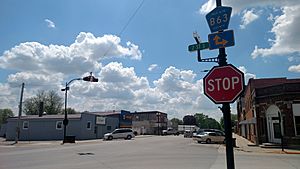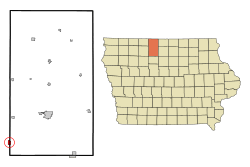West Bend, Iowa facts for kids
Quick facts for kids
West Bend, Iowa
|
|
|---|---|
 |
|
| Motto(s):
"A Rock Solid Community"
|
|

Location of West Bend, Iowa
|
|
| Country | |
| State | |
| Counties | Palo Alto, Kossuth |
| Area | |
| • Total | 0.88 sq mi (2.27 km2) |
| • Land | 0.88 sq mi (2.27 km2) |
| • Water | 0.00 sq mi (0.00 km2) |
| Elevation | 1,191 ft (363 m) |
| Population
(2020)
|
|
| • Total | 791 |
| • Density | 901.94/sq mi (348.22/km2) |
| Time zone | UTC-6 (Central (CST)) |
| • Summer (DST) | UTC-5 (CDT) |
| ZIP code |
50597
|
| Area code(s) | 515 |
| FIPS code | 19-83550 |
| GNIS feature ID | 0465615 |
| Website | City of West Bend, Iowa |
West Bend is a city in Kossuth and Palo Alto (originally) counties in the U.S. state of Iowa. The population was 791 at the time of the 2020 census.
History
West Bend had its start in the early 1880s by the building of the Burlington, Cedar Rapids and Northern Railway through that territory. It was originally called Ives after the president of the railroad, but the townspeople had it changed to West Bend from the bend in the river. West Bend (aka Ives) was the first town in Palo Alto County. A special five cent tax to build a railroad station was promised to the railroad if they would create a stop when the railroad was built. The railroad did that placing the line and the new station in West Bend.
Geography
The village straddles the county line, in the southwest part of Kossuth County and the southeast part of Palo Alto County, in northwestern Iowa. But, it was first in Palo Alto County.
According to the United States Census Bureau, the city has a total area of 0.89 square miles (2.31 km2), all land.
West Bend is served by a lightly-used former branch line of the Rock Island Railroad now owned by the Union Pacific Railroad.
Demographics
| Historical populations | ||
|---|---|---|
| Year | Pop. | ±% |
| 1890 | 325 | — |
| 1900 | 538 | +65.5% |
| 1910 | 679 | +26.2% |
| 1920 | 969 | +42.7% |
| 1930 | 634 | −34.6% |
| 1940 | 737 | +16.2% |
| 1950 | 772 | +4.7% |
| 1960 | 910 | +17.9% |
| 1970 | 865 | −4.9% |
| 1980 | 941 | +8.8% |
| 1990 | 862 | −8.4% |
| 2000 | 834 | −3.2% |
| 2010 | 785 | −5.9% |
| 2020 | 791 | +0.8% |
| Source: and Iowa Data Center Source: |
||
2010 census
As of the census of 2010, there were 785 people, 360 households, and 213 families living in the city. The population density was 882.0 inhabitants per square mile (340.5/km2). There were 396 housing units at an average density of 444.9 per square mile (171.8/km2). The racial makeup of the city was 99.1% White, 0.1% Native American, and 0.8% from two or more races. Hispanic or Latino of any race were 1.4% of the population.
There were 360 households, of which 20.8% had children under the age of 18 living with them, 51.7% were married couples living together, 4.4% had a female householder with no husband present, 3.1% had a male householder with no wife present, and 40.8% were non-families. 38.1% of all households were made up of individuals, and 23.6% had someone living alone who was 65 years of age or older. The average household size was 2.07 and the average family size was 2.71.
The median age in the city was 51.6 years. 18.1% of residents were under the age of 18; 7.4% were between the ages of 18 and 24; 15.5% were from 25 to 44; 26.8% were from 45 to 64; and 32.2% were 65 years of age or older. The gender makeup of the city was 46.4% male and 53.6% female.
Attractions
West Bend is the site of the Grotto of the Redemption, a series of nine contiguous grottos occupying a full city block, constructed of minerals, petrifications, and semiprecious gems. The Grotto of the Redemption is the inspiration and life work of Fr. Paul Dobberstein (1872-1954), a Catholic priest who settled in West Bend around 1902. For a decade he gathered rocks and precious and semi-precious stones from around the world beginning construction in 1912. For the next 42 years, Fr. Dobberstein created hundreds of intricate rock settings that form the Grotto’s walls and ceilings, evoking a spiritual experience. Matt Szerensce, a parishioner, and Fr. Louis Greving, the next Catholic pastor in West Bend, worked side-by-side with Fr. Dobberstein and furthered the work of Fr. Dobberstein after his death in 1954. Although the Grotto was technically finished in the late 1980, the Grotto is an ongoing work with restorations and repairs made yearly and there are still some statues that need to be purchased to complete certain scenes throughout the Grotto. The Grotto is non-profit and relies solely on donations for its maintenance and repair work.
The Grotto of the Redemption is the largest man-made grotto in the world and has an estimated 25-30 thousand visitors a year. The nine separate grottoes each depict a scene in the life of Jesus of Nazareth or of the testament of God. The theme of Redemption gives unity to this sacred space. Although the Grotto was built by a Catholic priest, Fr. Dobberstein, who was an avid rock hound, wanted the Grotto to be "non-denominational" or for all religions to appreciate and enjoy. His hope was to have the Grotto speak to all through the natural beauty of the stones and their arrangements.
Education
West Bend is part of the West Bend–Mallard Community School District, established by the merger of the West Bend and Mallard school districts in 1995.
Notable person
- Paul Dobberstein, German American priest and architect, most famous for constructing the Grotto of the Redemption; resident of West Bend
See also
 In Spanish: West Bend (Iowa) para niños
In Spanish: West Bend (Iowa) para niños


